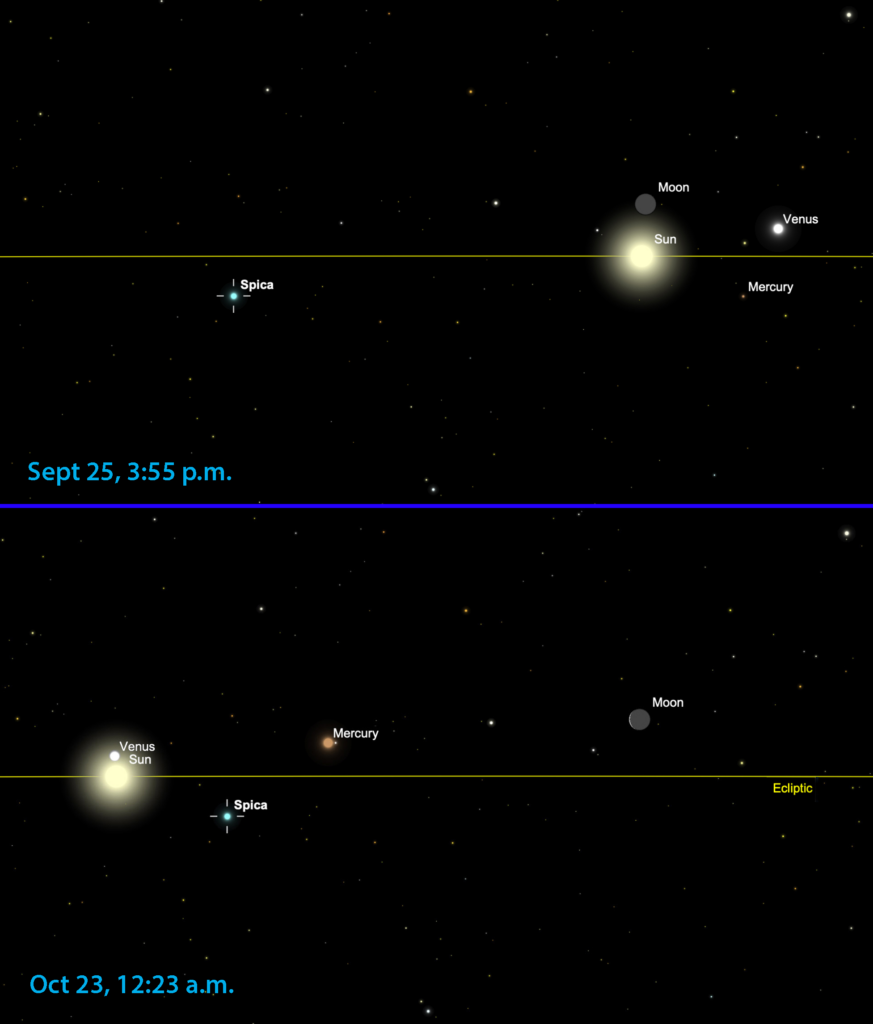Sky Report: September 19-25

First, a quick run-down of the three planets visible tonight.
Saturn is already up when the sun sets, and at the end of twilight you’ll find it low in the southeast, where it’s noticeably brighter than any nearby star. Saturn is highest around 11 p.m., and that’s the best time to observe it with a telescope, when it’s above the densest, warmest, and most turbulent layers of our atmosphere. Saturn is in eastern Capricornus. Be sure to finagle a look at Saturn through a friend’s telescope in the next month or two.
Jupiter rises in the east during evening twilight and is up before the sky is fully dark. Jupiter is by far the brightest object in the evening sky. It’s in Pisces, in an area of the sky that is totally absent of any bright stars.
Mars rises before midnight. It’s brighter than any star until Sirius rises, and its orange color gives it away.
Autumn begins at 7:04 p.m. MDT on the 22nd. That’s the date when the sun rises due east and sets due west – one of 2 days of year it does this (the equinoxes). The day and night are night equal in length, and sunrise and sunset would be 6 a.m. and 6 p.m. if you were in the center of your time zone and if it were not for Daylight Saving Time. For the next six months – in the northern hemisphere – the nights will be longer than the days.
The moon aligns with the sun and is new at 3:54:34 p.m. MDT on September 25th, and that begins a new lunar month. But how long is a month? The lengths of our calendar months were established by Julius Caesar in 46 BC and modified (and messed up) by his nephew Augustus a few years later, and their lengths are by decree: 30, 31, or 28 but sometimes 29, days. There are two lengths to an astronomical lunar month, depending on what you measure, and these are indeed measured, not set by decree. They are the time it takes the moon to orbit the earth and get back in front of the same stars (a sidereal month) and the slightly longer time it takes the moon to orbit the earth and get back to alignment with the sun (a synodic month; I mention their names so you can Google them). You have to specify circle the earth with respect to what? The graphic will explain: Note the stars the moon is in front of when it is new on Sept. 25th. On Oct. 23rd it has moved once around the earth relative to the stars, but during that month the sun has moved eastward 1/12th of the way around the sky, or about 30°. It takes the moon an additional 2 days and 3½ hours to catch up to the sun and become the “new moon” again. The sidereal month is 27.32 days and the synodic month is 29.53 days.
The Sky Report is presented as a public service by the Stellar Vista Observatory, a nonprofit organization based in Kanab, Utah, which provides opportunities for people to observe, appreciate, and comprehend our starry night sky. Additional information is at www.stellarvistaobservatory.org. Send questions and comments to John@StargazingAdventures.org.
John Mosley was Program Supervisor of the Griffith Observatory in Los Angeles for 28 years and is the author of “Stargazing for Beginners” and “Stargazing with Binoculars and Telescopes”. He and his wife live in St. George where he continues to stargaze from his retirement home while serving on the advisory committee for Stellar Vista Observatory.
Stellar Vista Observatory provides portable telescopes and tripod mounted binocular kits on loan for free to residents and visitors in Kane County. Enhance your enjoyment of the night sky! For details or to request a loan, visit https://stellarvistaobservatory.org/discover-the-night-sky/ or drop in to the Kane County Office of Tourism.






Comments are closed.